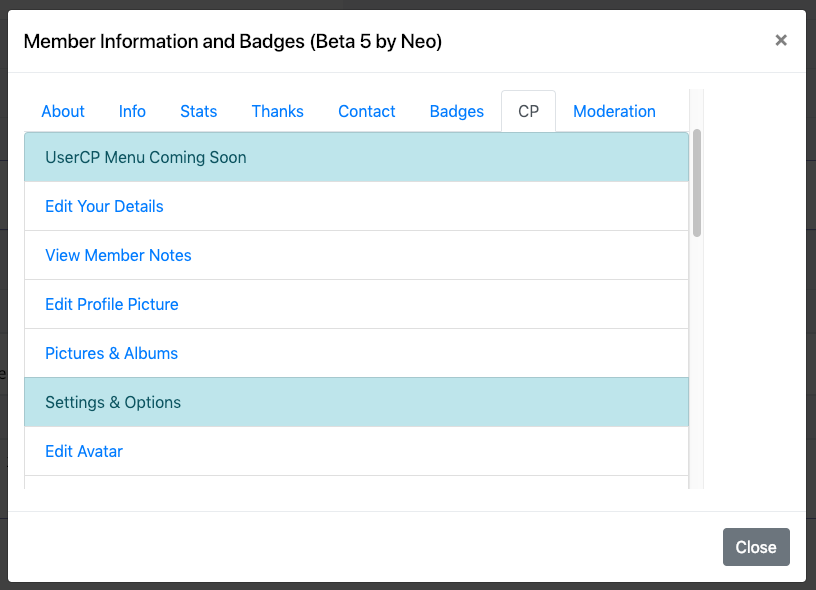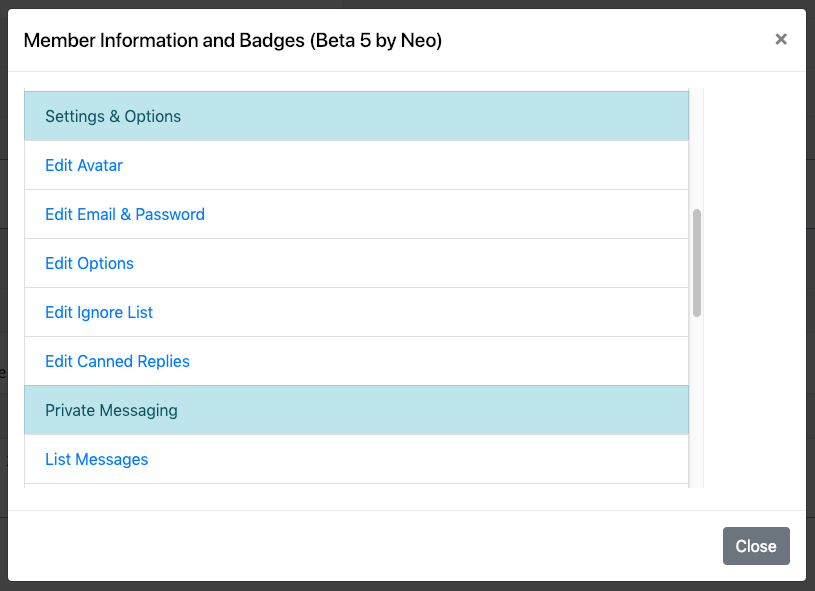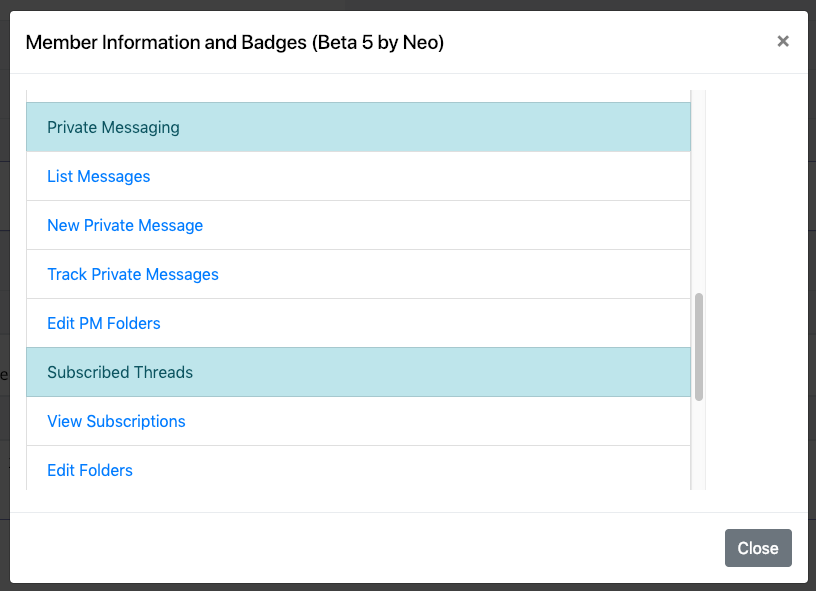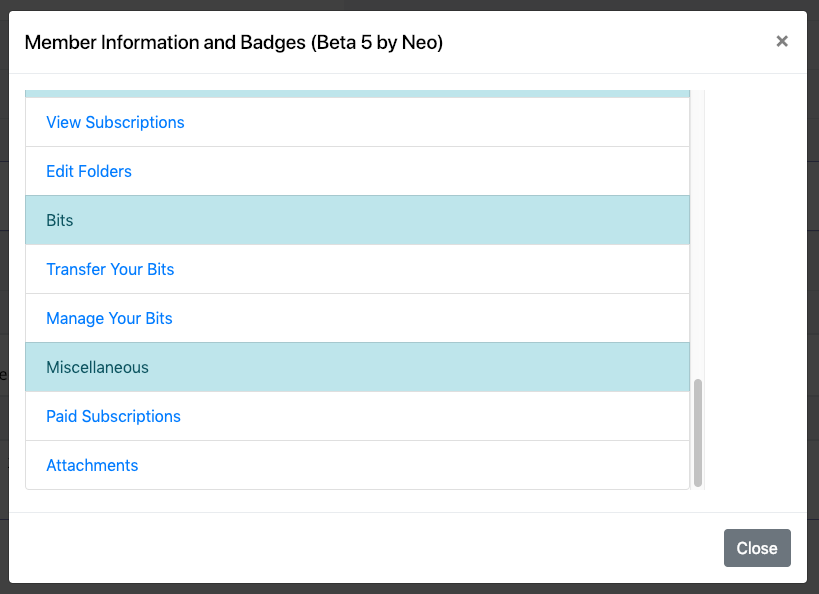|
|
Sponsored Content
The Lounge
What is on Your Mind?
UserCP Main Menu Moved to UIM
Post 303027741 by Neo on Sunday 23rd of December 2018 04:56:58 AM
|
|
4 More Discussions You Might Find Interesting
1. Shell Programming and Scripting
I have created a main menu in the following way:
while true; do
echo " "
echo "Main Menu: "
echo "Please Select An Option Using The Options Provided."
echo " "
echo "1 - Search All Files"
echo " "
echo "2 - Search Individual Files"
echo " "
... (1 Reply)
Discussion started by: amatuer_lee_3
1 Replies
2. Ubuntu
I have indeed succeeded in adding but not to the sub menu Internet, only when I ask for all the application I can see its icon.
How can I edit the unity dash manually?
Is there a text file for this?
Some kind of folder content?
I mean I used the app "main menu" and it add it... (4 Replies)
Discussion started by: programAngel
4 Replies
3. What is on Your Mind?
Update!
UserCP Screeching Frog 0.7485
Created a new page for uploaded a profile picture (profile pictures are different than avatar pictures).
https://www.unix.com/usercp/#/settings/other
https://www.unix.com/members/1-albums225-picture1158.png
... (0 Replies)
Discussion started by: Neo
0 Replies
4. UNIX for Beginners Questions & Answers
I installed CentOS 8 with Gnome 3.28.2 and I noticed that the "switch user" menu item disappeared from under the system menu of Gnome classic (Both X11 & Wayland). I checked google and this problem seems to have a history going back several releases of Gnome.
Unfortunately, I never found a... (1 Reply)
Discussion started by: bodisha
1 Replies
LEARN ABOUT DEBIAN
rrdcgi
RRDCGI(1) rrdtool RRDCGI(1) NAME
rrdcgi - Create web pages containing RRD graphs based on templates SYNOPSIS
"#!/path/to/"rrdcgi [--filter] DESCRIPTION
rrdcgi is a sort of very limited script interpreter. Its purpose is to run as a cgi-program and parse a web page template containing special <RRD:: tags. rrdcgi will interpret and act according to these tags. In the end it will printout a web page including the necessary CGI headers. rrdcgi parses the contents of the template in 3 steps. In each step it looks only for a subset of tags. This allows nesting of tags. The argument parser uses the same semantics as you are used from your C-shell. --filter Assume that rrdcgi is run as a filter and not as a cgi. Keywords RRD::CV name Inserts the CGI variable of the given name. RRD::CV::QUOTE name Inserts the CGI variable of the given name but quotes it, ready for use as an argument in another RRD:: tag. So even when there are spaces in the value of the CGI variable it will still be considered to be one argument. RRD::CV::PATH name Inserts the CGI variable of the given name, quotes it and makes sure it starts neither with a '/' nor contains '..'. This is to make sure that no problematic pathnames can be introduced through the CGI interface. RRD::GETENV variable Get the value of an environment variable. <RRD::GETENV REMOTE_USER> might give you the name of the remote user given you are using some sort of access control on the directory. RRD::GOODFOR seconds Specify the number of seconds this page should remain valid. This will prompt the rrdcgi to output a Last-Modified, an Expire and if the number of seconds is negative a Refresh header. RRD::INCLUDE filename Include the contents of the specified file into the page returned from the cgi. RRD::SETENV variable value If you want to present your graphs in another time zone than your own, you could use <RRD::SETENV TZ UTC> to make sure everything is presented in Universal Time. Note that the values permitted to TZ depend on your OS. RRD::SETVAR variable value Analog to SETENV but for local variables. RRD::GETVAR variable Analog to GETENV but for local variables. RRD::TIME::LAST rrd-file strftime-format This gets replaced by the last modification time of the selected RRD. The time is strftime-formatted with the string specified in the second argument. RRD::TIME::NOW strftime-format This gets replaced by the current time of day. The time is strftime-formatted with the string specified in the argument. Note that if you return : (colons) from your strftime format you may have to escape them using if the time is to be used as an argument to a GRAPH command. RRD::TIME::STRFTIME START|END start-spec end-spec strftime-format This gets replaced by a strftime-formatted time using the format strftime-format on either start-spec or end-spec depending on whether START or END is specified. Both start-spec and end-spec must be supplied as either could be relative to the other. This is intended to allow pretty titles on graphs with times that are easier for non RRDtool folks to figure out than "-2weeks". Note that again, if you return : (colon) from your strftime format, you may have to escape them using if the time is to be used as an argument to a GRAPH command. RRD::GRAPH rrdgraph arguments This tag creates the RRD graph defined by its argument and then is replaced by an appropriate <IMG ... > tag referring to the graph. The --lazy option in RRD graph can be used to make sure that graphs are only regenerated when they are out of date. The arguments to the RRD::GRAPH tag work as described in the rrdgraph manual page. Use the --lazy option in your RRD::GRAPH tags, to reduce the load on your server. This option makes sure that graphs are only regenerated when the old ones are out of date. If you do not specify your own --imginfo format, the following will be used: <IMG SRC="%s" WIDTH="%lu" HEIGHT="%lu"> Note that %s stands for the filename part of the graph generated, all directories given in the PNG file argument will get dropped. RRD::PRINT number If the preceding RRD::GRAPH tag contained and PRINT arguments, then you can access their output with this tag. The number argument refers to the number of the PRINT argument. This first PRINT has number 0. RRD::INTERNAL <var> This tag gets replaced by an internal var. Currently these vars are known: VERSION, COMPILETIME. These vars represent the compiled-in values. EXAMPLE 1 The example below creates a web pages with a single RRD graph. #!/usr/local/bin/rrdcgi <HTML> <HEAD><TITLE>RRDCGI Demo</TITLE></HEAD> <BODY> <H1>RRDCGI Example Page</H1> <P> <RRD::GRAPH demo.png --lazy --title="Temperatures" DEF:cel=demo.rrd:exhaust:AVERAGE LINE2:cel#00a000:"D. Celsius"> </P> </BODY> </HTML> EXAMPLE 2 This script is slightly more elaborate, it allows you to run it from a form which sets RRD_NAME. RRD_NAME is then used to select which RRD you want to use as source for your graph. #!/usr/local/bin/rrdcgi <HTML> <HEAD><TITLE>RRDCGI Demo</TITLE></HEAD> <BODY> <H1>RRDCGI Example Page for <RRD::CV RRD_NAME></H1> <H2>Selection</H2> <FORM><INPUT NAME=RRD_NAME TYPE=RADIO VALUE=roomA> Room A, <INPUT NAME=RRD_NAME TYPE=RADIO VALUE=roomB> Room B. <INPUT TYPE=SUBMIT></FORM> <H2>Graph</H2> <P> <RRD::GRAPH <RRD::CV::PATH RRD_NAME>.png --lazy --title "Temperatures for "<RRD::CV::QUOTE RRD_NAME> DEF:cel=<RRD::CV::PATH RRD_NAME>.rrd:exhaust:AVERAGE LINE2:cel#00a000:"D. Celsius"> </P> </BODY> </HTML> EXAMPLE 3 This example shows how to handle the case where the RRD, graphs and cgi-bins are separate directories #!/.../bin/rrdcgi <HTML> <HEAD><TITLE>RRDCGI Demo</TITLE></HEAD> <BODY> <H1>RRDCGI test Page</H1> <RRD::GRAPH /.../web/pngs/testhvt.png --imginfo '<IMG SRC=/.../pngs/%s WIDTH=%lu HEIGHT=%lu >' --lazy --start -1d --end now DEF:http_src=/.../rrds/test.rrd:http_src:AVERAGE AREA:http_src#00ff00:http_src > </BODY> </HTML> Note 1: Replace /.../ with the relevant directories Note 2: The SRC=/.../pngs should be paths from the view of the webserver/browser AUTHOR
Tobias Oetiker <tobi@oetiker.ch> 1.4.7 2008-12-22 RRDCGI(1)



